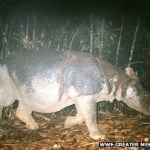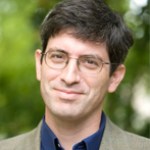Life Sciences
Dr. Jon Costanzo, Senior Research Scholar and Adjunct Professor in the Department of Zoology at Miami University in Oxford, OH was invited to tell us about his amazing research on wood frogs; animals that can actually survive freezing! Here is his post:
In a recent post, Dr. Dolittle commented on our poster.pdf presented at the Ohio Physiological Society's meeting in Cincinnati, Ohio. We reported on seasonal variation in the abundance of proteins within the liver of the wood frog (Rana sylvatica), the most cold adapted of all North American amphibians. The wood frog is one of about a dozen…
The last known Javan rhinoceros from the subspecies Rhinoceros sondaicus annamiticus was found dead in Vietnam with its horn cut off, most likely a victim of poachers. Another subspecies, The Indian Javan rhino (R. sondaicus inermis), is believed to have gone extinct in the early 20th century.
With only about 50 members left from the Indonesian subspecies, R. sondaicus sondaicus, in West Java, the outlook for these animals is bleak.
Sources:BBC News
CP Groves, DM Leslie. Rhinoceros sondaicus (Perissodactyla: Rhinocerotidae). Mammalian Species, 43(1):190-208. 2011.
Ramono, W., Isnan, M. W…
According to this press release:
Scientists have proven that the fungus Geomyces destructans causes white-nose syndrome, a fast-spreading and highly lethal disease of bats.
Research published today (Wednesday, Oct. 26) in the journal Nature provides the first direct evidence that this fungus is responsible for a disease that is decimating bats in North America.
Research at the USGS National Wildlife Health Center in Madison, by scientists from the U.S. Geological Survey, the University of Wisconsin-Madison, and other institutions, showed that 100 percent of healthy little brown bats exposed…
I was just reading the National Geographic's Daily News and came across this article about the unearthing of a 2.5-million-year-old skull from a new species (Panthera zdanskyi) of tiger. What was interesting is that the skull of modern tigers is really not that different showing that the anatomy of tiger skulls have been ideal for the hunting needs of these animals for millions of years. That brings a whole new meaning to the phrase "if it isn't broken, don't fix it."
The day your son asks for a genetically engineered glow-in-the dark zebra fish and your wife desires a mauve rose may be the day that public acceptance of plant and animal genetic engineering has finally arrived.
Last week the U.S. Department of Agriculture concluded that a new variety of rose, genetically engineered to be an unusual shade of blue, does not pose a risk to the economy or ecosystems. This decision paves the way for the company, Florigene, to sell cut roses in the US. The mauve creation is based on the discovery by Davis-based biotech pioneer Calgene Inc, which isolated the "…
From Yale Environment 360, more questions about future UN population projections:
For now, we can indeed be highly confident that world population will top 7 billion by the end of this year. We're close to that number already and currently adding about 216,000 people per day. But the United Nations "medium variant" population projection, the gold standard for expert expectation of the demographic future, takes a long leap of faith: It assumes no demographic influence from the coming environmental changes that could leave us living on what NASA climatologist James Hansen has dubbed "a…
Image source: Virgin Media
Sandtiger shark (Carcharias taurus) pups emerge from the womb as experienced killers. Since they develop teeth and the ability to swim while still in the womb, the strongest embryo will actually kill and eat its siblings (embryophagy) and their yolk sacs. This ensures that the surviving embryo has sole access to the unfertilized eggs that are continuously produced by the mother. Since they have two uteri, these sharks give birth to two live offspring whereas other shark species with less intrauterine killing instincts may deliver a brood of up to a dozen or so. In…
How does David Attenborough crawl through a marshy Cycad forest toward an exposed rocky ledge overlooking a vast plain of grazing dinosaurs, drawing ever closer to a nesting colony of Quetzalcoatlus Pterodactlyoids (known in the business as "Flying Giraffes") camera crew in tow, nearly out of breath, turning to the camera and speaking of how his adrenalin is surging as he can feel the breeze caused by wingbeats of one of the larger males taking off down an historically ancient Pterosaur runway, and noting a few interesting facts about their physical adaptations to flight and their behavior…
This guest post was written by Brookhaven Lab science writing intern Kenrick Vezina, who joined our team this month and will be sharing Brookhaven science stories from inside and outside laboratories on site through mid December.
On Saturday, September 10, I rode into Brookhaven National Laboratory for the first time. Within two hours, I was watching a handful of white-tailed deer on a strip of grass near the Princeton Avenue gate.
I'm a new intern in the Lab's Media & Communications Office, fresh from MIT's Graduate Program in Science Writing, here to report on all of the fascinating…
Picking up where yesterday's post left off, we have one more point to consider. Recall that the set-up here is that Edward Feser suggested a reinterpretation of the Adam and Eve story to bring it into line with modern genetics. In particular, Feser's scenario hypothesizes that Adam and Eve were selected from a population of hominids to receive the gift of an eternal soul. Those other hominids were biologically human, but since they lacked souls they were not metaphysically human. I replied in this post. Feser then replied to my reply here.
In yesterday's post I discussed two objections…
The Species Seekers: Heroes, Fools, and the Mad Pursuit of Life on Earth sounds like a cool book, though I've not read it yet. From Publisher's Weekly:
Until about 1834, the word "scientist" didn't exist. According to naturalist Conniff (Swimming with Piranhas at Feeding Time), it was likely at a meeting of the British Association for the Advancement of Science) where a member, following the model of "artist" and "atheist," coined a new term--"scientist" reflecting the transition of the nascent study of plants and animals from self-educated hobbyists to a new breed of professional. The…
Edward Feser has posted a reply to my previous post about original sin. I shall reply in two posts, but that will be it from my side. If Feser wants to reply to these posts then he can have the last word.
The problem is this: Several lines of evidence tell us that there was never a time when the human population was exactly two. It also tells us that humanity is one endpoint of billions of years evolution by natural selection. This conflicts with religious accounts holding that Adam and Eve were created instantaneously and were the only humans on the planet at that time. Thus, if we…
Why is it so hard to understand a commonplace thing like orgasms?I think I know why science does not understand the female orgasm. It is because science excels when it breaks free of context, history, human complexities and anthropology, but when a topic requires one to grasp context, history, human complexities and anthropology, then science, especially the hard sciences, can fall short. Also, the nature of the female orgasm is a comparative question, but human sexuality is highly (but not entirely) derived; It is difficult to make a sensible graph or table comparing aspects of sexuality…
I like to pass books about science on to the teachers in my daughter's school for them to have in the classroom (or to pass on to the library, as they wish). Now that you've heard this idea, you will want to do it to!
Here's a few suggestions of recent titles that could be available used or cheap.
Galapagos Diary: A Complete Guide to the Archipelgo's Birdlife
... in our look at bird books to consider, I wanted to bring in the Galapagos Diary. I cannot tell you which is the best book for birding in the Galapagos, because, sadly, I've never done that myself. But my daughter, Julia, has,…
Back when I reviewed Mann's pop-archaeology classic 1491, I mentioned that I'd held off reading it for a while for fear that it would be excessively polemical in a "Cortez the Killer" kind of way. Happily, it was not, so when I saw he had a sequel coming out, I didn't hesitate to pick it up (in electronic form, this time).
As you can probably guess from the title and subtitle, 1493 is about what happened after Europeans made contact with the Americas. This covers a wide range of material, from straight history, to biology, to economics, but the central theme of the whole thing is basically…
This is one beautiful plesiosaur, Polycotylus latippinus.
(Click for larger image)
(A) Photograph and (B) interpretive drawing of LACM 129639, as mounted. Adult elements are light brown, embryonic material is dark brown, and reconstructed bones are white. lc indicates left coracoid; lf, left femur; lh, left humerus; li, left ischium; lp, left pubis; rc, right coracoid; rf, right femur; rh, right humerus; ri, right ischium; and rp, right pubis.
The unique aspect of this specimen is that it's the only pregnant plesiosaur found; the fore and hind limbs bracket a jumble of bones from a juvenile…
I have lived among Cannibals, according to a lot of people who claim to know. The number of times that the "tribal" people of the Congo have been called cannibals is too great to be counted, most notably in great literature like The Heart of Darkness but most commonly, I suspect, from the pulpit or soap box by those raising money to spread this or that word. Most Europeans and Americans don't know it, but many people who live in the Congo are quite convinced that the bazunga ... the white foreigners ... are cannibals. I've listened closely these assertions, made by many individuals, and I'…
I learned something new today, and something surprising. I've opened up my fair share of bellies and seen intestines doing their slow peristaltic dance in there, and I knew in an abstract way that guts were very long and had to coil to fit into the confined space of the abdominal cavity, but I'd always just assumed it was simply a random packing — that as the gut tube elongated, it slopped and slithered about and fit in whatever way it could. But no! I was reading this new paper today, and that's not the case at all: there is a generally predictable pattern of coiling in the developing gut,…
AT&T sponsored Nifty Fifty program speaker and widely acclaimed science writer Carl Zimmer just published this very interesting New York Times piece on "...a small but growing number of field biologists who study urban evolution -- not the rise and fall of skyscrapers and neighborhoods, but the biological changes that cities bring to the wildlife that inhabits them. For these scientists, the New York metropolitan region is one great laboratory." Carl brings to light recent findings on mice stranded on isolated urban islands that are evolving to adapt to urban stress, fish in the Hudson…
A proposal has been made to remove beloved Archaeopteryx from the bird family tree and push it over to some non-avian dinosaur subtree. This is not the first time that the ancient species has had its position on the tree of bird life threatened, but this time it may be for real. The proposal is reasonable.
I've talked about this issue before, but I'm bringing it up now because there is a new paper, just out. Lets get right down to business and start with the abstract:
Archaeopteryx is widely accepted as being the most basal bird, and accordingly it is regarded as central to understanding…







